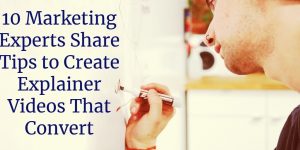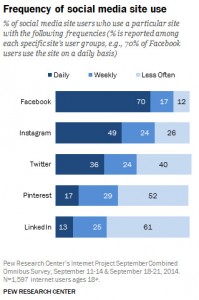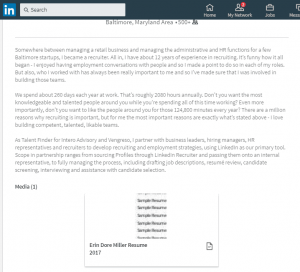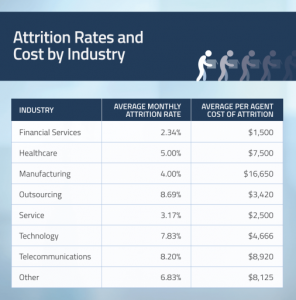
Live video is the most talked-about tool among social media marketers right now.
Marketers from small businesses to large corporations are jumping on the live video trend, and it’s working. People spend 3 times longer watching live video on Facebook compared to non-livestreamed video content.
I’ve been a guest on several live video interviews, as well as a viewer, and I’ve picked up on some tips to keep in mind if you’re considering adding live video to your marketing.
Let’s look at five best practices for live video:
1. Choose the right tool
There are lots of options for livestreaming tools, but the most popular tools right now are Facebook Live, Periscope, and Blab.
Here’s a quick overview of each:
- Facebook Live is Facebook’s livestreaming tool for your business page. You can stream live right from your smartphone’s Facebook Pages app. Once you start your broadcast, fans get a Facebook notification that you are livestreaming. Many businesses are using Facebook Live as a way to share more information about what they do by holding livestream Q&As, or to give followers a behind-the-scenes look at their people, environment, or products. Viewers can ask questions or provide feedback during your broadcast by commenting or using Facebook Reactions on the livestream post.
- Periscope, which is owned by Twitter, is another app you can use to livestream from your smartphone. Businesses on Periscope use their broadcasts similarly to those using Facebook Live — they stream Q&As and show behind-the-scenes of their business, while their audience participates by commenting through the Periscope app. A major difference with Periscope is its Twitter integration. You can post your livestream to Twitter, and your followers don’t have to leave Twitter to watch your Periscope broadcast — it auto-plays in the tweet. This is a great option for anyone whose Twitter audience is more engaged than their Facebook audience.
- Blab is a livestreaming tool you can use on your smartphone or desktop computer, and it allows you to have up to four people livestreaming at once. Think of Blab as a livestreaming talk show. Like Facebook Live and Periscope, you can run your Blab broadcast as a Q&A or behind-the-scenes look with an audience chat feature, but having four seats provides you with even more possibilities. You can interview experts or customers, let audience members take over one of the four seats to ask questions or provide their point of view, or use one of the seats for Blab’s dropins feature, where you can share a link to anything (think Infographics, related YouTube videos, or Slideshares) on the web.
2. Promote your broadcast in advance
If no one knows about your livestream, you won’t have an audience! Blab will let you schedule your broadcast in advance, and gives you a link to share on social media. Anyone who registers on the page will see a countdown clock and they’ll get a reminder about your event. When your broadcast starts, Blab, Facebook Live, and Periscope will also provide notifications to users who follow you that you are livestreaming.
Don’t forget to go beyond the livestreaming tools themselves to promote your livestream event. Create images using tools like Canva or PicMonkey that list your livestream’s topic, time, date, and platform and post those images in advance on social media, in your emails, and on your blog.
3. Create a plan for engagement
Live video works because viewers want the opportunity to interact with the people behind the brand. They’re eager for a chance to connect with you, and they’re going to ask you a lot of questions. Do your best to answer what you can. If you’re using Blab, assign one of your hosts or guests to help type answers in the live chat or to pick questions you want to discuss on air.
In addition to answering questions, you can greet viewers by name as they arrive to your livestream. Ask them to share where they’re watching you from in the comments, and note the locations out loud. You may be surprised to see viewers tune in from across the world! Greeting your viewers and discussing where they are is a nice icebreaker to start your broadcast.
Social media marketing expert Kim Garst often starts her Periscope broadcasts by asking viewers where they’re from, and it gets the conversation going right away:

Whether you’re starting out with a small audience or have been broadcasting for a while, it’s always a good idea to have a list of questions and talking points that you want to cover in case your viewers are shy and don’t ask questions right away.
4. Include a call to action
Always leave your viewers wanting more from you. Tell them about other ways they can keep in touch by following you on other social networks or subscribing to your newsletter. Provide them with some valuable content — you can add a link in one of the Blab seats to a free download, an informational video, or your email signup page — the list is endless.
Social media marketing platform Post Planner always includes a call to action in their Blab broadcasts to download a piece of helpful content, either by using a link dropin or displaying it on a sign.

5. Extend the life of your livestream
Your livestream can have a long shelf life after the broadcast is over. Facebook Live and Blab will save your videos to your profile. Periscope videos disappear within 24 hours, but it has an autosave feature that lets you record the broadcast on your phone for future use.
You can upload your Blab videos to YouTube from your account, and upload your recorded Periscope videos to YouTube from your phone. If you’re using Facebook Live, make your live broadcasts easy to find by creating a special video playlist for them.
Facebook marketing expert Mari Smith is a regular Facebook Live broadcaster, and she’s organized all of her livestreams in one playlist in the video section of her Facebook page:

Link to your livestream videos in social media posts, email newsletters, and blog posts. Remind your followers about your event, and let them know they can view it if they missed it.
Tip: You can also write a blog post that recaps what you talked about in the video and embed the stream in your post. Then share your recap blog post using all of your marketing tools.
Interested in more video marketing tips?
Video is one of the most engaging tools you can use whether you’re reaching out to your audience through a live broadcast or an edited recording. For more tips on using video on social media and in your email marketing, check out our
Have questions on livestreaming? Leave us a comment.
Digital & Social Articles on Business 2 Community(56)
Report Post








